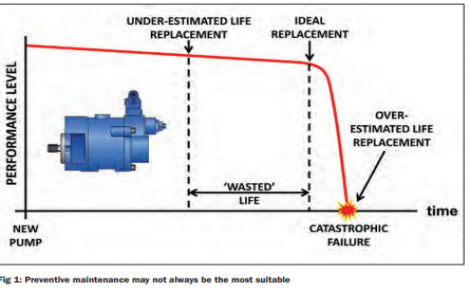- Home » Editorial » Hydraulics
Seven reasons to monitor hydraulic flow on mobile machines

4. Monitor drive motor efficiency to save fuel
Cuthbert also explains that for actuators that operate continuously over long periods, such as those found on conveyor or mixer drives, comparing the actuator flow rate to the actuator speed will establish its volumetric efficiency. He adds that any deterioration in efficiency will therefore signal the need for remedial action. In addition, this approach takes into account any leakage from the inlet port to the outlet port that would not be obvious simply by monitoring the case drain flow.
Such a strategy is also applicable to the overall machine. If the engine is only driving hydraulics, then measuring the hydraulic power output will reveal the power output of the entire machine, which indicates how long the fuel/battery will last.
5. Improve certainty with closed-loop speed control
Using closed-loop feedback will help to optimise flow control, says Cuthbert, particularly where an actuator is operating in a hostile environment. Where actuators function in challenging conditions, possibly subject to rain or salt water, electrical discharges or lightning strikes, or extreme temperatures, monitoring and transmitting the actuator speed by electrical sensors and cabling may prove problematic.
Instead, Cuthbert comments that a feedback signal proportional to the actuator speed is obtainable by monitoring the actuator flow rate, which is then suitable for use in the closed-loop speed control system of the actuator. This signal can relay back to the proportional hydraulic flow control valve, with flow adjusted accordingly.
6. Enhance safety
Cuthbert highlights that any mobile machine with hydraulic flow presents a safety risk if someone inadvertently opens a cover, for example. Normal practice here is the use of trip switches, but these are not tamper-proof. Flow monitoring is a good back-up strategy.
By monitoring pump flow, the system designer has a built-in secondary safety function with real-time feedback. It is possible to see whether the pump is delivering flow or not by witnessing whether oil is returning to tank or the motor drive. The set-up can subsequently enable/disable other functions to keep operators safe.
7. Elimination of Live work (ELW)
In a continuous drive to improve safety in the heavy machinery industry, Cuthbert comments that OEMs, dealers and operators in the construction & mining industry are increasingly focussed on how such machines can be maintained and repaired without a person having to enter the machine while its operating, hence the phrase Elimination of Live Work. Traditionally, he says, to test a hydraulic pump on a machine you would need two technicians to attend to fit the flow meter into the circuit, and then for one to run the machine while the other monitors the pump performance. By using a permanently installed flow monitor, no additional equipment needs to be installed, so only one person is required to carry out the job and flow rates can be monitored remotely thus removing the technician from a potentially dangerous environment.
*******************************************************************************************************
Webtec is a hydraulic measurement and control company that designs, manufactures and distributes a world-class range of hydraulic components and hydraulic test equipment for the mobile and industrial machinery markets.
The company, whose headquarters are based in St Ives, Cambridgeshire, UK is privately owned and employs around 70 people in the UK, North America, Germany and Hong Kong.
*******************************************************************************************************
For further information visit www.webtec.com
https://twitter.com/webtec_products
https://www.linkedin.com/company/webtec-products-limited/
-
SMART Manufacturing & Engineering Week
04 - 05 June, 2025
NEC, Birmingham UK -
PPMA 2025
23 September, 2025, 9:30 - 25 September, 2025, 16:00
NEC, Birmingham UK -
Advanced Engineering Show 2025
29 October, 2025, 9:00 - 30 October, 2025, 16:00
NEC, Birmingham UK










